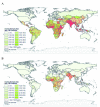Drivers of the reduction in childhood diarrhea mortality 1980-2015 and interventions to eliminate preventable diarrhea deaths by 2030
- PMID: 31673345
- PMCID: PMC6815873
- DOI: 10.7189/jogh.09.020801
Drivers of the reduction in childhood diarrhea mortality 1980-2015 and interventions to eliminate preventable diarrhea deaths by 2030
Abstract
Background: Childhood diarrhea deaths have declined more than 80% from 1980 to 2015, in spite of an increase in the number of children in low- and middle-income countries (LMIC). Possible drivers of this remarkable accomplishment can guide the further reduction of the half million annual child deaths from diarrhea that still occur.
Methods: We used the Lives Saved Tool, which models effects on mortality due to changes in coverage of preventive or therapeutic interventions or risk factors, for 50 LMIC to determine the proximal drivers of the diarrhea mortality reduction.
Results: Diarrhea treatment (oral rehydration solution [ORS], zinc, antibiotics for dysentery and management of persistent diarrhea) and use of rotavirus vaccine accounted for 49.7% of the diarrhea mortality reduction from 1980 to 2015. Improvements in nutrition (stunting, wasting, breastfeeding practices, vitamin A) accounted for 38.8% and improvements in water, sanitation and handwashing for 11.5%. The contribution of ORS was greater from 1980 to 2000 (58.0% of the reduction) than from 2000 to 2015 (30.7%); coverage of ORS increased from zero in 1980 to 29.5% in 2000 and more slowly to 44.1% by 2015. To eliminate the remaining childhood diarrhea deaths globally, all these interventions will be needed. Scaling up diarrhea treatment and rotavirus vaccine, to 90% coverage could reduce global child diarrhea mortality by 74.1% from 2015 levels by 2030. Adding improved nutrition could increase that to 89.1%. Finally, adding increased use of improved water sources, sanitation and handwashing could result in a 92.8% reduction from the 2015 level.
Conclusions: Employing the interventions that have resulted in such a large reduction in diarrhea mortality in the last 35 years can virtually eliminate remaining childhood diarrhea deaths by 2030.
Copyright © 2019 by the Journal of Global Health. All rights reserved.
Conflict of interest statement
Competing interests: NO and LL work for the Bill & Melinda Gates Foundation that provided funding for the analyses. The authors completed the Unified Competing Interest form at www.icmje.org/coi_disclosure.pdf (available upon request from the corresponding author), and declare no further conflicts of interest.
Figures



References
-
- Hill K, Pebley AR.Child Mortality in the Developing World. Popul Dev Rev. 1989;15:657-87. 10.2307/1972594 - DOI
-
- Bellagio Study Group on Child Survival. Knowledge into action for child survival. 2003;362:323-7. - PubMed
-
- United Nations. Millennium development goals report 2015. New York, NY. United Nations. 2015. Available: http://www.un.org/millenniumgoals/2015_MDG_Report/pdf/MDG%202015%20rev%2.... Accessed: 25 April 2017.
-
- United Nations. Department of Economic and Social Affairs. Transforming our world: the 2030 agenda for sustainable development. Resolution adopted by the General Assembly 2015. Available: https://sustainabledevelopment.un.org/post2015/transformingourworld. Accessed: 25 April 2017.
MeSH terms
Grants and funding
LinkOut - more resources
Full Text Sources
Medical
